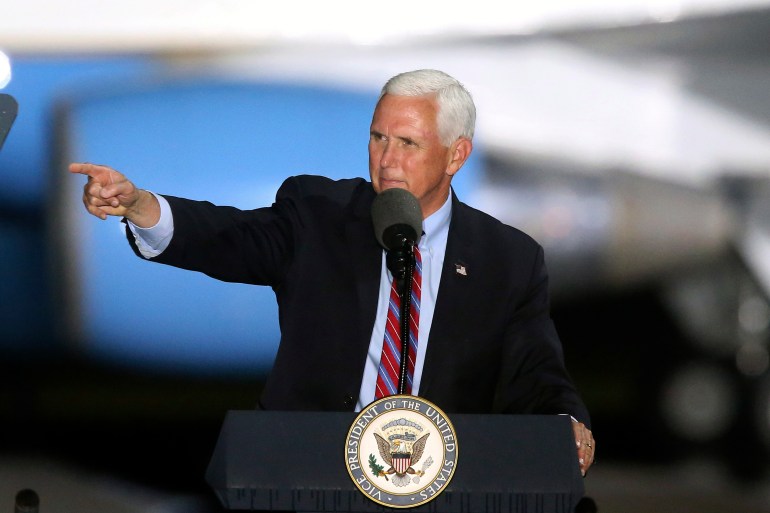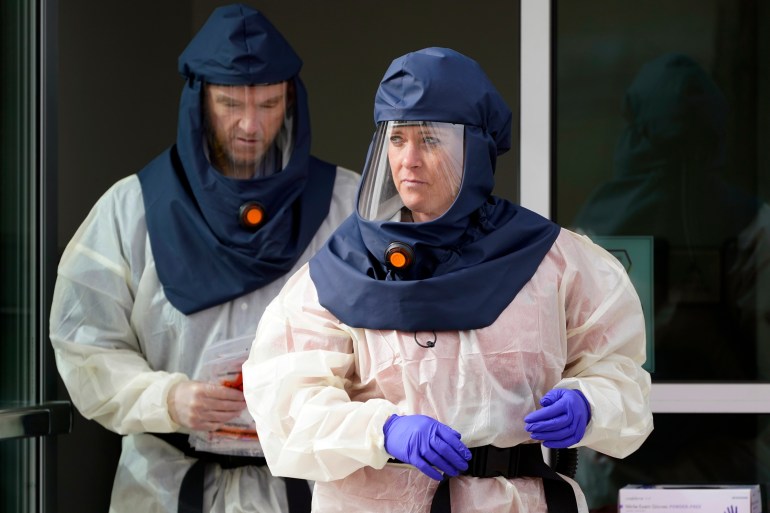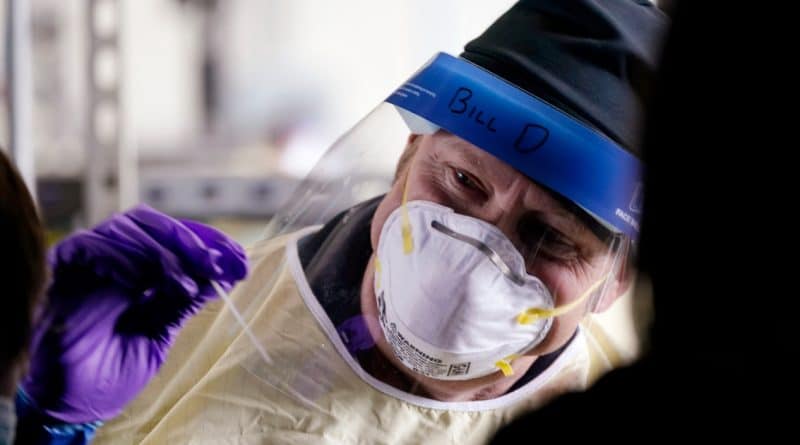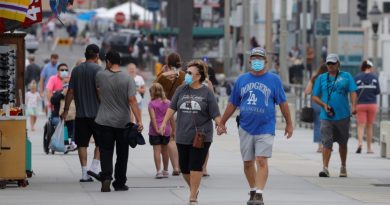COVID-19 deaths are rising in the US, as feared by experts | US & Canada
Deaths per day from the coronavirus in the US are on the rise again, just as health experts had feared, and cases are climbing in practically every state, despite assurances from President Donald Trump during the weekend that “we’re rounding the turn, we’re doing great.”
With election day just more than a week away, average deaths per day across the country are up 10 percent across the past two weeks, from 721 to nearly 794 as of Sunday, according to data from Johns Hopkins University. Confirmed infections per day are rising in 47 states, and deaths are up in 34.
Health experts had warned that it was only a matter of time before deaths turned upward, given the record-breaking surge in cases engulfing the country. Deaths are a lagging indicator – that is, it generally takes a few weeks for people to sicken and die from the coronavirus.
Michael Osterholm, a University of Minnesota expert on infectious diseases who warned of a potential surge during autumn in the US, said what’s happening now is a confluence of three factors: “pandemic fatigue” among people who are weary of hunkering down and are venturing out more; “pandemic anger” among those are do not believe the scourge is a real threat; and cold weather, which is forcing more Americans indoors, where the virus can spread more easily than outside.
“When you put those three together, we shouldn’t be surprised what we’re seeing,” Osterholm said.
The virus is blamed for more than 8.6 million confirmed infections and more than 225,000 deaths in the US, the highest such totals anywhere in the world.
Deaths are still well below the US peak of more than 2,200 per day in late April. But experts are warning of a grim autumn and winter in the US, with a widely cited model from the University of Washington projecting about 386,000 dead by February 1. A vaccine is unlikely to become widely available until mid-2021 at the earliest.
The seven-day rolling average for daily new cases hit a record high on Sunday of 68,767, according to Johns Hopkins, eclipsing the previous mark of 67,293, set in mid-July. The US recorded more than 80,000 new cases on both Friday and Saturday – the highest marks ever – though testing has expanded dramatically during the course of the outbreak, making direct comparisons problematic.
The true number of infections is thought to be far higher because many Americans have not been tested, and studies suggest people can be infected without feeling sick.
Fears about the virus’s toll on the economy – and fading hopes that the federal government will be able to deliver more relief anytime soon – sent stocks into a slump in afternoon trading on Wall Street.
The S&P 500 was 2.3 percent lower and on track for its worst day in more than a month. The Dow Jones Industrial Average was down more than 800 points, or almost 3 percent.
During the final presidential debate last week, Trump downplayed the virus’s effect in Texas, saying: “There was a very big spike in Texas, it’s now gone.”
On Sunday, White House Chief of Staff Mark Meadows said that “we’re not going to control the pandemic” and that the focus should be on containment and treatment.
 Vice President Mike Pence has continued to campaign as members of his inner circle test positive for coronavirus [Steve Cannon/AP Photo]
Vice President Mike Pence has continued to campaign as members of his inner circle test positive for coronavirus [Steve Cannon/AP Photo]Trump, who spent several days in the hospital after contracting the virus, said repeatedly during the weekend that the country is “rounding the turn.” His remarks came amid another outbreak in the White House inner circle. Several close aides to Vice President Mike Pence tested positive, including his chief of staff.
Strained states
In the US, Oklahoma is one of the states consistently breaking records for new cases, and the strain is being felt in hospitals. Bed space is running out, and an equally daunting problem is a shortage of nursing staff.
Dr Sam Ratermann, director of the hospitalist program at INTEGRIS Grove Hospital in Grove, Oklahoma, said his organisation is offering a hiring bonus of up to $25,000 for experienced nurses. He said patients are being transferred from “hospital to hospital across the state” due to a lack of beds.
“Even when we have open ICU beds across the state, we don’t have staff to fill them,” Ratermann said. “There’s going to be a point where there’s no beds, and we can’t even care for our local citizens.”
In the Texas border city of El Paso, authorities instructed people to stay home for two weeks and imposed an overnight curfew because of a surge that has overwhelmed hospitals. The state is converting part of the city’s civic centre into a hospital.
 Salt Lake County Health Department public health nurses look on during coronavirus testing outside the Salt Lake County Health Department [File: Rick Bowmer/AP Photo]
Salt Lake County Health Department public health nurses look on during coronavirus testing outside the Salt Lake County Health Department [File: Rick Bowmer/AP Photo]Violators of the curfew are subject to fines, though the order does not apply to people who are going to or from work or are out for other essential reasons, such as food shopping and medical care.
On Monday, the county reported a record high in daily cases, with 1,443. The county had 853 patients hospitalised because of the virus, up from 786 a day earlier. The state has provided more than 900 medical personnel to El Paso, some of whom will staff the convention centre site.
In Kentucky, the state shattered its record for the number of new cases per week, with 9,335. Democratic Governor Andy Beshear announced plans to make recommendations soon for counties with high rates of infection.
The University of Minnesota’s Osterholm has been predicting the darkest days will be in the weeks or months ahead. He said he expects increased competition for drugs and shortages of hospital specialists, N95 masks and other protective gear.
A strong national response plan was needed, along with consistent messaging that emphasised mask wearing and other preventive measures, Osterholm told The Associated Press news agency.
“But our response has been … I don’t know what our response has been,” he said.


